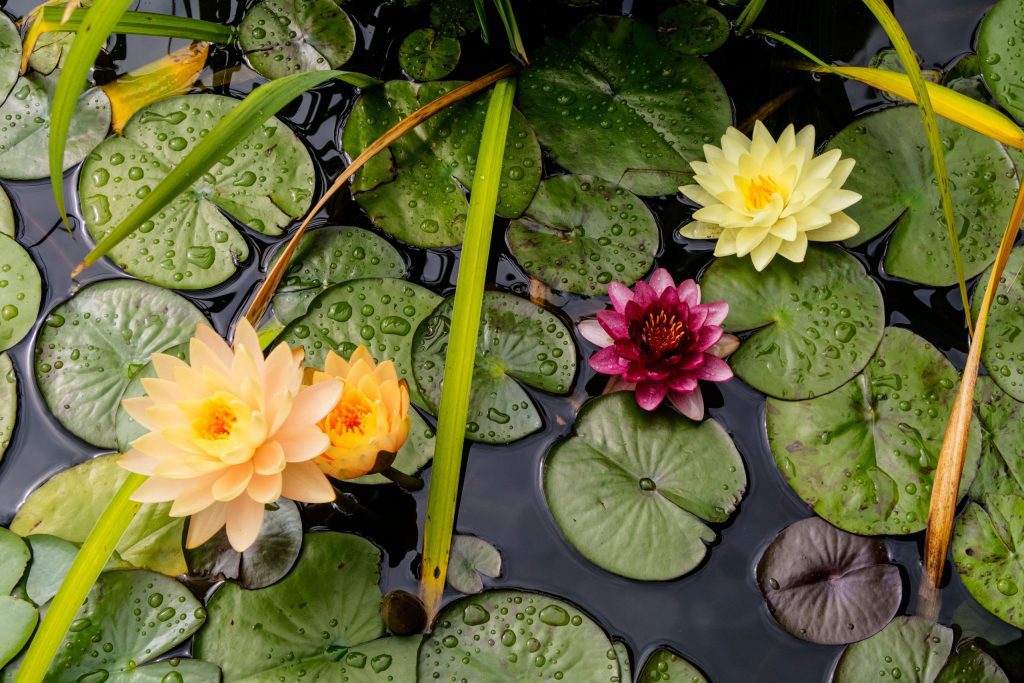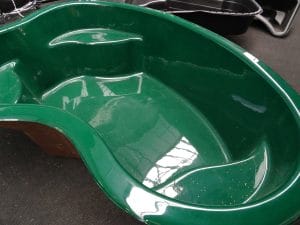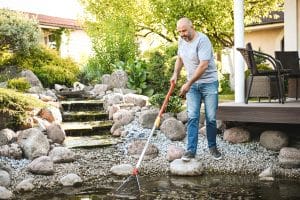
Pond Plants: A Beginner's Guide to Planting Your Garden Pond Effectively
Unsure how to start planting your garden pond? This “pond plants: a beginner’s guide to planting your garden pond” will help you pick the right pond plants and show you how to plant them effectively for a lush and healthy pond.
Key Takeaways
Pond plants enhance ecological balance by providing oxygen, improving water quality, and attracting wildlife, crucial for a healthy garden pond.
Selecting appropriate pond plants based on water depth and space is vital to prevent overcrowding and ensure a thriving ecosystem.
Maintaining pond plants through regular pruning, monitoring for invasive species, and using native plants contributes to a sustainable and visually appealing aquatic environment.
Understanding Pond Plants
Pond plants, also known as aquatic plants, thrive in watery environments and are essential to any garden pond. They provide aesthetic beauty and crucial ecological functions, with various types each playing a unique role in the pond’s ecosystem.
There are five main categories of pond plants: submerged, marginal, floating, emergent, and bog plants. Submerged plants, as the name suggests, grow entirely underwater, creating an underwater forest that supports aquatic life. Marginal plants grow around the edges of ponds in shallow water. Floating plants rest on the water’s surface, helping to control algae and maintain water temperature. Emergent plants root into the pond sides and bottom, with their flowers blooming above the water. Bog plants thrive in the wet soil around the pond’s edge, often found in bog gardens.
Waterlilies are a classic example of pond plants, with almost 40 varieties ranging from pure white to deep crimson. These and other pond plants not only enhance the visual appeal of your garden pond but also attract wildlife, improve water quality, and create a natural habitat for various organisms.
Benefits of Adding Pond Plants
Adding pond plants to your garden pond offers numerous benefits that go beyond mere aesthetics. Aquatic plants are vital for maintaining ecological balance, as they produce oxygen through photosynthesis, which is crucial for the survival of fish and other aquatic life. Submerged plants, in particular, play a key role in oxygenating the water, ensuring a healthy environment for all pond inhabitants.
Pond plants act as natural filters, absorbing excess nutrients and pollutants from the water, thereby improving water quality. This filtration process helps control algae growth by competing for the same nutrients that algae thrive on. Floating plants, for instance, provide shade on the water’s surface, reducing sunlight penetration and further inhibiting algae growth.
Beyond their ecological benefits, pond plants also enhance the visual appeal of your garden pond throughout the year. With a variety of plant types, including marginal, floating, and oxygenating plants, you can create a dynamic and ever-changing display that attracts wildlife and adds seasonal interest. Whether you have a small pond or a larger water feature, incorporating a diverse range of pond plants will undoubtedly enrich your garden’s ecosystem.
Choosing the Right Pond Plants
Selecting the right pond plants is crucial for creating a balanced and thriving ecosystem in your garden pond. It is essential to choose plants that match the size of your pond to prevent overcrowding. Overcrowded ponds can lead to poor water quality and hinder the growth of individual plants.
Consider the specific water depth required by each plant type to ensure they thrive in their new environment. Submerged plants need deeper water, while marginal plants prefer shallow edges.
Carefully selecting plant pond plants that match your pond’s characteristics ensures a healthy and visually appealing aquatic garden.
Planting Pond Plants
Planting pond plants involves more than just placing them in water. Most pond plants are planted into a mesh basket filled with substrate and gravel, allowing their roots to establish firmly. This method prevents soil from leaching into the water and provides stability for the plants.
Specific planting techniques are required for each type of pond plant, as detailed in the following subsections.
Submerged Plants
Submerged plants, also known as oxygenating plants, grow entirely underwater and are crucial for maintaining a healthy pond ecosystem. These submerged aquatic plants produce oxygen through photosynthesis, helping to keep the water clear and supporting aquatic life. Examples of submerged plants include hornwort, Elodea, and Eelgrass, which provide excellent cover and habitat for fish and other organisms.
For submerged plants, use a mesh basket with aquatic compost and gravel, ensuring they are fully submerged and positioned at the pond’s bottom to establish their roots and thrive.
Regular maintenance, such as thinning out overgrown plants, will help keep your pond healthy and balanced.
Floating Plants
Floating plants, like water lilies and floating hearts, rest on the water’s surface and play a significant role in regulating water temperature and controlling algae growth. By providing shade, floating plants reduce the amount of sunlight that penetrates the water, thereby inhibiting algae proliferation. This shading effect also helps keep the water cooler during hot summer months.
Floating plants need ample space to spread across the water’s surface. Proper placement maximizes their benefits and prevents overcrowding. Regular pruning and thinning maintain their health and effectiveness.
Marginal Plants
Marginal plants grow around the edges of ponds in shallow water and are essential for nutrient uptake and erosion control. These plants thrive in waterlogged soil and are typically placed around 10 cm deep in the water. Examples of marginal pond plants include water irises, marsh marigolds, and water mint, which not only enhance the pond’s beauty but also provide habitats for wildlife.
Plant marginal plants in a mesh basket with aquatic compost and gravel. Position the basket at the pond’s edge so that the plant crowns are just above the water level, allowing roots to establish while benefiting from the water’s moisture and nutrients.
Maintaining Your Pond Plants
Proper maintenance ensures the health and balance of your garden pond. Regular pruning, especially for floating plants, prevents them from overtaking the pond and blocking sunlight. Cut most marginal plants back to about 15 cm above the water level in autumn to encourage new growth in spring.
Dividing overgrown plants prevents overcrowding, encourages new growth, and revitalizes older plants. Check and clean plants for pests like duckweed before reintroducing them to the pond to avoid problems.
Leaving some silt at the bottom of the pond provides habitat for overwintering wildlife. Use a fine mesh net to remove excess silt to maintain water quality and prevent odors. These maintenance tips will help ensure a thriving and balanced garden pond.
Best Native Pond Plants for Garden Ponds
Choosing native pond plants for your garden pond offers several advantages. Native plants are more resilient to local environmental conditions and require less maintenance. They are also better suited to supporting local wildlife, providing essential habitats and food sources.
Popular native pond plants include Marsh Marigolds, which are known for their heart-shaped leaves and bright yellow flowers that attract pollinators. Water lilies are another excellent choice, offering stunning blooms and shade for aquatic life.
By incorporating native plants, you can create a beautiful and sustainable garden pond that enhances local biodiversity.
Essential Accessories for Pond Planting
Several accessories are essential for successfully planting and maintaining pond plants. Specialist pond compost, low in nutrients, is recommended for aquatic life and prevents nutrient leaching. Aquatic planting baskets retain soil while allowing water circulation and come in various shapes to meet different planting needs.
Floating plant islands offer a unique way to cultivate plants directly on the water’s surface, enhancing both aesthetics and biodiversity. Fertilizer balls designed for aquatic environments promote healthy plant growth, ensuring your pond plants thrive.
Avoiding Problematic Pond Plants
While many pond plants offer benefits, some can become problematic and should be avoided. Duckweed, for example, can form dense mats on the water’s surface, obstructing sunlight and creating hazards for other aquatic life. Similarly, invasive species like milfoil and cabomba can disrupt the pond’s ecosystem by outcompeting native plants.
Avoid planting invasive species and regularly monitor the pond for problematic plants to maintain a balanced and healthy pond. This ensures your pond remains a thriving and beautiful part of your garden.
Creating Wildlife-Friendly Ponds
Creating a wildlife-friendly pond goes beyond planting the right plants. Some pond plants serve as habitats for aquatic life, enhancing biodiversity. Native pond plants, in particular, provide essential habitats and food sources for local wildlife, supporting a balanced ecosystem.
Designing your pond with varied depths and irregular edges encourages diverse species to thrive. A sloping side allows easier access for wildlife and creates a damp habitat for smaller creatures. Adjacent habitats, like tall grass and dense shrubs, support wildlife movement and provide cover for animals approaching the pond.
Small spaces can also benefit from wildlife-friendly ponds. Container ponds enhance small outdoor areas by adding aesthetic appeal and wildlife habitats. Incorporating these design elements creates a pond that supports a thriving ecosystem while looking beautiful.
Small Ponds and Container Ponds
Small ponds and container ponds provide unique opportunities to plant compact and visually appealing aquatic plants. Dwarf water lilies and miniature bulrushes are excellent choices for their manageable size and stunning blooms. Vertical reeds and compact irises add vibrant color and structure, ideal for limited spaces.
For container ponds, choose plant varieties that thrive in confined environments. Mini marginals, for instance, flourish in limited spaces, offering both beauty and ecological benefits.
Choosing plants allows you to create a charming and functional water feature, even in the smallest garden.
Summary
In summary, planting and maintaining pond plants in your garden pond brings numerous benefits, from enhancing visual appeal to supporting local wildlife. By choosing the right plants and following proper planting and maintenance techniques, you can create a thriving and balanced ecosystem. Start your pond planting journey today and transform your garden into a serene and beautiful oasis.
Frequently Asked Questions
Why are submerged plants important for a garden pond?
Submerged plants are essential for a garden pond as they produce oxygen through photosynthesis, promoting water clarity and supporting the overall health of aquatic life. Their presence creates a balanced ecosystem that enhances your pond’s vitality.
How do floating plants help control algae growth?
Floating plants effectively control algae growth by providing shade, which limits sunlight penetration and hinders algae’s ability to thrive. This natural mechanism fosters a healthier aquatic environment.
What are some examples of native pond plants?
Native pond plants such as Marsh Marigolds, Waterlilies, and Brooklime thrive in their local environments and provide valuable support for wildlife. Incorporating these plants can enhance the health and biodiversity of your pond.
How can I maintain my pond plants?
Maintaining your pond plants requires regular pruning, dividing any overgrown varieties, and monitoring for pests. These tasks are crucial for ensuring their health and vitality.
What accessories are essential for pond planting?
To successfully plant in a pond, ensure you have specialist pond compost, aquatic planting baskets, floating plant islands, and fertilizer balls. These accessories are crucial for promoting healthy aquatic plant growth.



